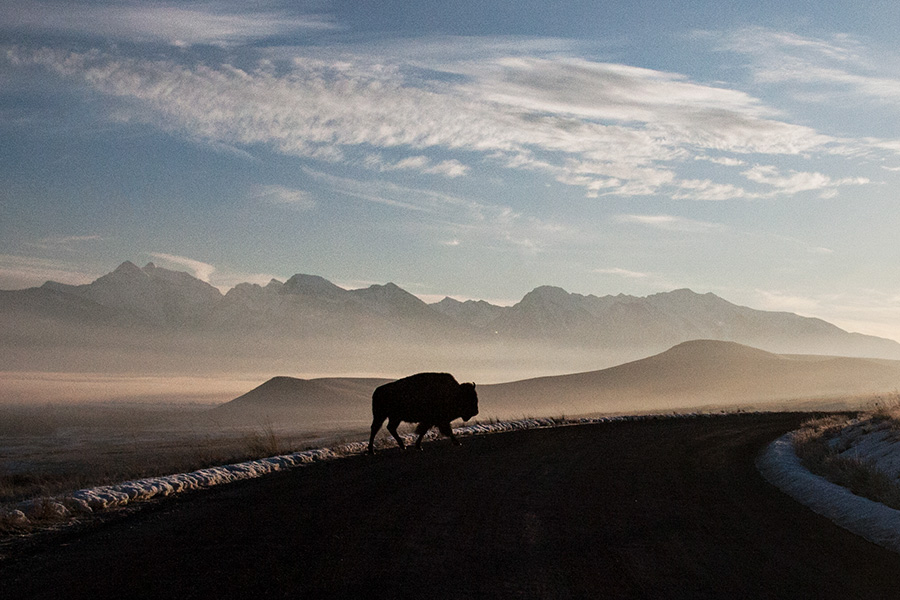Visiting the National Bison Range in Moiese is akin to stepping back in time, when the shag-haired, curve-horned, hump-backed animals roamed the Great Plains in massive herds.
From an historic population of between 30 and 60 million animals roaming across North America, bison reached a population low of 100 in the wild in the late 1800s.
Since 1908, the National Bison Range has played an important role in the successful recovery of the striking creatures, as well as preserving their genetic health, said Bernie Petersen, the U.S. Fish and Wildlife Service’s acting project manager at the National Bison Range.
Bison once ranged across the continent in herds numbering from fewer than 10 to more than 10,000, making it one of the most numerous large mammals to ever exist on the planet, with around 32 million living on the Great Plains alone, ranging the arid grasslands paralleling the eastern flank of the Rocky Mountains from the Texas Panhandle to Southern Canada. An estimated 4 to 8 million bison were likely scattered to the north, south, east, and west of the plains.
But pressures on bison began mounting with competition for forage from horses, brought over in the 16th century by Spanish explorers. Further competition came in the form of cattle, which also brought communicable diseases. The demand for bison robes and leather increased the hunting pressure by Native Americans and fur trappers, while the railroads paid professional hunters to provide meat for workers.
In 1880, the mass slaughter began as millions of bison were shot for their meat and hides and for sport. Carcasses were left to rot in the prairie sun, and by 1883 they were close to extinction.
When President Theodore Roosevelt established the National Bison Range in 1908, there had never been an appropriation of money to buy lands expressly to provide shelter and space for wildlife, and bison began regaining an iconic status.
Today, as one of the three initial reserves set aside for the preservation of American bison, the National Wildlife Refuge in Moiese continues to play an important role in the success story of recovery of the once endangered plains bison.
The herd is maintained at about 350 animals, while excess bison are sold or donated to provide a gene pool and breeding stock to augment other herds.
The mission of the National Bison Range is “to provide a representative herd of bison, or buffalo, under reasonably natural conditions, to help ensure the preservation of the species for continued public benefit and enjoyment.”
To help carry out that mission, last month refuge managers, biologists, veterinarians, and others assessed the herd’s health condition and genetics during the annual bison roundup, conducted each year to preserve the genetics of the prized herd, considered among the strongest and purest in the nation.
Those with more diluted genetic purities are “surplussed,” or culled from the herd and sold to other refuges, as well as privately owned herds attempting to refine the animals’ genetics.
“We have some of the purest bison that are out there right now,” Petersen said.
Petersen said this year’s roundup, which was delayed due to fire hazards and restrictions, was the picture of success, with no injuries or fatalities to humans or animals, which he attributed to the use of increasingly un-intrusive methods to corral the bison from throughout the 19,000-acre refuge and into pens.
“I credit a lot of how smooth it went to the staff and how they actually handled the animals,” he said. “They were calm and quiet and low key, whereas in the past there has been a lot of yelling and shouting and rattling cans to get the herd to move. Now we have a much more subdued method.”
The wranglers use a long pole with a piece of tarp lashed to the end, which makes a soft flapping noise in the breeze signaling the animals to move.
Although the herd ranges on a fenced-in refuge, the animals are managed as wildlife rather than livestock, Petersen said.
“We do consider them wildlife, so we interfere as little as possible,” he said. “However, we do have a carrying capacity, so we can’t just allow them to continue reproducing without culling some animals. Otherwise we would destroy the habitat.”
Each animal is equipped with a microchip, which contains genetic and health information that is tracked in a refuge-wide database. The animals with the strongest genetics are maintained on the refuge, while those with weaker genes are distributed.
This year, the Rocky Mountain Arsenal National Wildlife Refuge in Colorado received 25 bison, while another 10 went to a brand new herd in the Eastern Shoshone Tribe’s Wind River Reservation. The last 15 were sold to private entities through a sealed bid process.
Although biologists look for outward signs of disease during the roundup, Petersen said the bison aren’t vaccinated or wormed like cattle.
The range is also home to pronghorn antelope, elk, bighorn sheep (the herds of which have been severely reduced due to a strain of pneumonia), grizzlies, and birds. Numerous wildlife management programs are underway to monitor the bison as well as the other wildlife populations.
